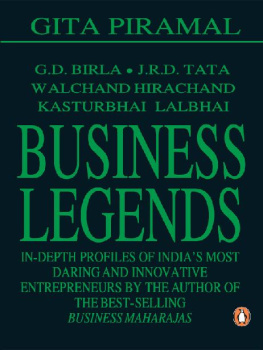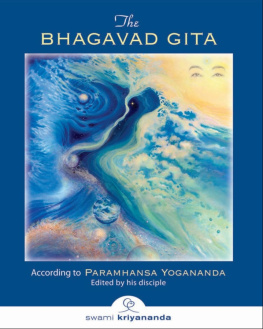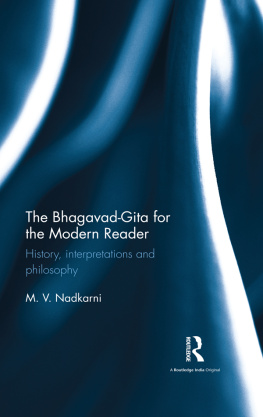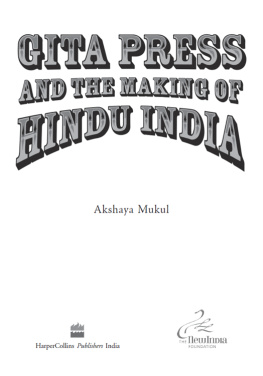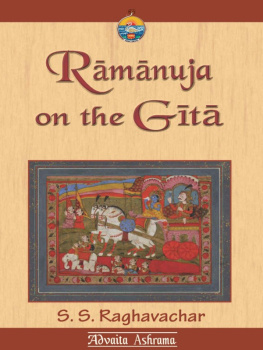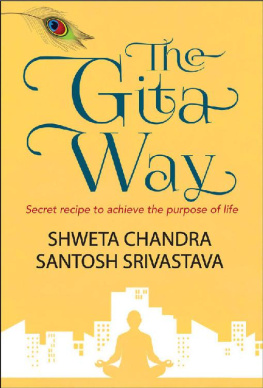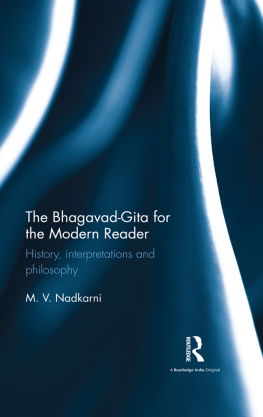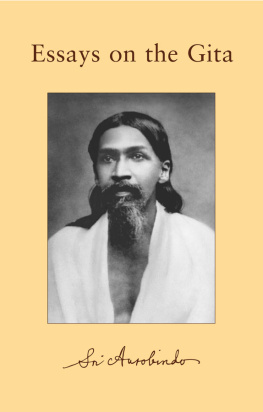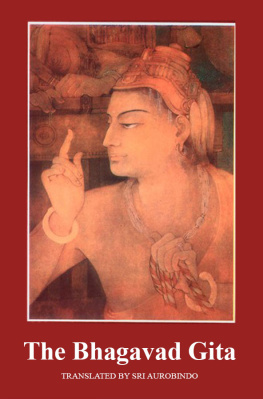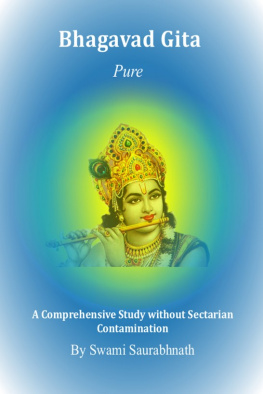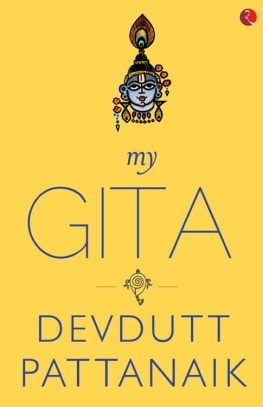GITA PIRAMAL
Business Legends
PENGUIN BOOKS
Contents
PENGUIN BOOKS
BUSINESS LEGENDS
A freelance journalist with a Ph.D. in business history, Gita Piramal is the author of the best-selling Business Maharajas and the co-author of a pioneering work on business history, Indias Industrialists. She has also contributed to the seminal volume Business and Politics in IndiaA Historical Perspective , edited by Dr Dwijendra Tripathi and published by the Indian Institute of Management, Ahmedabad. She has been writing and commenting on the corporate sector for over eighteen years for leading Indian and international newspapers such as the UKs Financial Times and Economic Times.
Piramal has been involved in the making of television programmes on Indian business for the BBC and for Plus Channel.
She is married to industrialist Dilip G. Piramal and they have two daughters, Aparna and Radhika. Piramal divides her time between Mumbai and London.
To Ajay, David, Harsh and Rahul
Introduction
BUSINESS HISTORY HAS always fascinated me, so much so that I invested eight years for a doctorate in it. Unlike other freshly minted Ph.Ds, however, I never got round to publishing my research. This was partly because of my desire to use it to compilesome day in the nebulous futurean annotated bibliography on the economic history of Bombay. Such a project would be far more useful than my dissertation, I felt, yet the dissertation was the foundation for a more useful book. I resolutely shelved years of hard labour waiting for the right moment to arrive.
The moment came unexpectedly and I was quick to seize it. While chatting with other business historians, I heard about the Lalbhais treasure trove of old letters. The entire collection of Kasturbhai Lalbhais correspondence had been carefully storedand the family was willing to allow me to rifle through them. Thousands of letters which no one had ever seen! I felt as Aladdin must have as I unpacked the red cloth potlas into which the files were stuffed. Postcards from Mahatma Gandhi, the grey hand-made silk paper wedding invitation of Rajiv and Sonia Gandhi, angry exchanges between Kasturbhai Lalbhai and the income tax authorities, the arbitration papers dividing the brothers assets, a sons sorrow over his mothers illnesshistory came to life in front of my eyes. The added advantage was that my training and reading enabled me to grasp the contents of the letters, and to sift the trivial from the critical.
I am fascinated by people and their legacies, but that doesnt explain why todays manager should bother to read about yesterdays entrepreneurs. After all, business at the threshold of the millennium is quite different from what it was fifty years ago. The environment has changed, as have the products and the pace of response. With nothing in common, what possible lessons can there be in the lives of four long-gone businessmen to justify time spent reading these pages?
Quite a lot, actually. Because the similarity between India just before and after independence and India in the nineties is far greater than between India in the eighties and the nineties.
If this proposition seems rather extravagant, consider this:
Competition. Indian entrepreneurs of the Raj such as G.D. Birla and Kasturbhai Lalbhai competed fiercely for market share on their home turf against the giant multinationals of the day. Imports then were unrestricted. It was only as India headed towards her first forex crisis after independence that the Nehru administration clamped down on imports, a policy which was subsequently followed by a major import substitution programme. This resulted in a sellers market until the nineties. If you could wrangle a licence, you could print money on the back of it. During the licence-permit raj, Aditya Birla (GDs grandson) and Rahul Bajaj (chairman of Bajaj Auto, one of the worlds top five two-wheeler companies) had the luxury of being able to sell everything they produced. Their grandparents didnt enjoy this luxury in the past, nor will their children do so in the future.
Government. There was no level playing field under the Raj or after it. On the contrary, while the British ruled, Indians were discriminated against in their own country. Banks, for example, wouldnt lend Indians money unless it was at exorbitant rates, while the same banks would easily help out British businessmen in India. Government policy actively favoured British business especially in cotton textiles, jute and exports. Discrimination continued after the British left. Indira Gandhis mania for control led to the birth of the licence raj, her appetite for donations to the permit raj. The Congress partys skewed policies created a situation where some businessmen were more equal than others.
Technology. Todays managers are as frightened of technology and its impact on business as were those of the fifties. The seventies and eighties were far more comfortable because little technological innovation took place behind Indias closed borders. In the forties, there was little data on which to base forecasts about which products would sell, or predict the size of the market. Today, advances in technology and the speed at which it is adopted have made the process equally daunting.
Yet, even in this hostile environment, yesterdays entrepreneurs succeeded in establishing significant corporate dynasties. According to Thomas Timberg, author of The Marwaris, essentially the period from 1951 to 1962 might be described as the Golden Age of Indian private capital. Industrial production increased at a rate of roughly 9 per cent a year; and the production of certain commodities even more rapidly. For three decades after that, politicians, economists and businessmen tried to simulate this feat, but the country remained mired in the so-called Hindu rate of growth of 3 per cent. However, today the Indian economy is vibrant once again and the liberalization process of the early nineties has created an environment which fosters aggressive entrepreneurship similar to the earlier era.
During the pre- and post-independence period, several entrepreneurs outperformed the rest, producing products and services which were globally competitive. Four in particularG.D. Birla, Walchand Hirachand Doshi, Kasturbhai Lalbhai and J.R.D. Tataare particularly outstanding for their contribution to Indian industry.
In a 1939 listing of Indias biggest business housesboth local and foreignthe Tata Group topped the roll of honour with assets of Rs. 62.42 crores. The second largest, Martin Burn, was a poor second, with assets of a mere Rs. 18 crores. This was a formative age for the other three businessmen profiled here. The Birla group, at 13th place, owned assets of Rs. 4.85 crores, the Lalbhais had half that with Rs. 2.33 crores and ranked 30th. Walchand, in fact, was bigger than the Birlas at that point of time with assets of Rs. 3.66 crores in Scindia (ranked 17th but where he had three partners) and another Rs. 2.61 crores in his own group (25th).
By 1969 the picture had changed dramatically. The white burra sahebs had more or less abandoned their companies to Indians. According to the Report of the Industrial Licensing Policy Inquiry Committee, the Tata group remained Indias biggest business house with assets of Rs. 505.36 crores, but the Birlas had leapfrogged other groups to become the second largest in the country with assets of Rs. 456.40 crores. JRD and GD were running neck and neck despite the Tatas century-long advantage. This was a growth period for the Walchand group as well and they jumped to 9th rank with assets of Rs. 81.11 croresand this didnt take into account Scindias Rs. 55.99 crores as the group had parted ways with the shipping firm by then. Had they managed to retain control of the shipping giant, the Doshis would have hauled themselves to 4th place. At 18th place with Rs. 51.20 crores in assets, the Lalbhais hadnt done too badly either.



